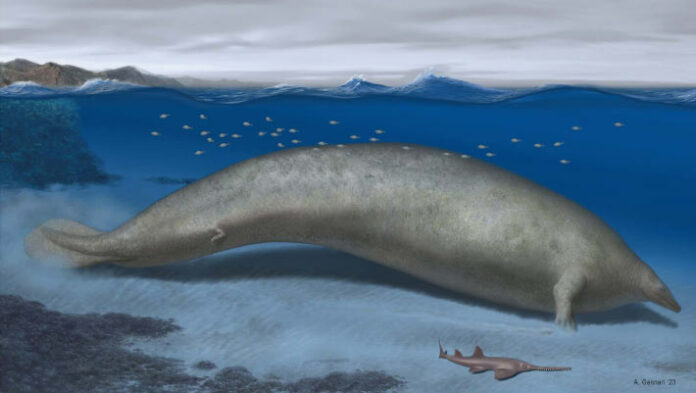Paleontologists from the University of California, Davis, and Smithsonian Institution’s National Museum of Natural History estimate that Perucetus colossus, a giant basilosaurid whale from the Eocene of Peru, weighed 60-70 tons assuming a length 17 m.
Reconstruction of Perucetus colossus in its coastal habitat; the associated sawfish, Pristis, was recovered from the same unit in the East Pisco Basin, the Yumaque Member of the Paracas Formation, Peru. Image credit: A. Gennari.
Perucetus colossus lived approximately 39 million years ago (Eocene period) in what is now Peru.
First described in 2023, this species was a type of basilosaurid, a family of extinct cetaceans that lived during the Eocene and are known from all continents, including Antarctica.
“Perucetus colossus’ bones are unusually dense,” said University of California, Davis Professor Ryosuke Motani and Smithsonian Institution’s Dr. Nicholas Pyenson.
“Mammal bones usually have a solid exterior and are spongy or hollow in the center. Some animals have more of the center filled in with solid bone, making them dense and heavy.”
“In aquatic animals, heavy bones can offset buoyancy from body fat and blubber, allowing the animal to maintain neutral buoyancy in water or — in the case of the hippopotamus — to walk on river beds.”
“The fossil whale bones have both extensive in-filling and extra growth of bone on the outside as well, a condition called pachyostosis also seen in some modern aquatic mammals, such as manatees.”
In 2023, paleontologists estimated a body mass for Perucetus colossus of 180 metric tons (ranging from 85 to 340 metric tons).
This would make Perucetus colossus as heavy as, or heavier than the biggest blue whales known, even though it is considerably shorter at 17 m long compared to a blue whale at about 30 m.
“These estimates would make Perucetus colossus impossibly dense,” Professor Motani said.
“It would have been a job for the whale to stay at the surface, or even to leave the sea bottom — it would have required continuous swimming against the gravity to do anything in the water.”
The authors reexamined the assumptions used to make those estimates.
“The first problem is that the original study used the fossil bones to estimate the weight of the skeleton, then extrapolated to the weight of the entire animal, assuming that the skeletal and non-skeletal mass would scale at the same rate with increasing body size,” they said.
“But measurements of other animals show this is not the case.”
“The original estimates also overestimated how much overall body mass increases as a result of pachyostosis.”
“But evidence from manatees shows that their bodies are relatively light relative to their skeletal mass.”
Professor Motani and Dr. Pyenson estimate that the 17-m long Perucetus colossus weighed in at 60 to 70 tons, considerably less than the known weights of blue whales.
An individual of Perucetus colossus that grew to 20 m could weigh over 110 tons, still well short of the largest blue whales at 270 tons.
“The new weight allows the whale to come to the surface and stay there while breathing and recovering from a dive, like most whales do,” Professor Motani said.
The results appear online in the journal PeerJ.
_____
R. Motani & N.D. Pyenson. 2024. Downsizing a heavyweight: factors and methods that revise weight estimates of the giant fossil whale Perucetus colossus. PeerJ 12: e16978; doi: 10.7717/peerj.16978


